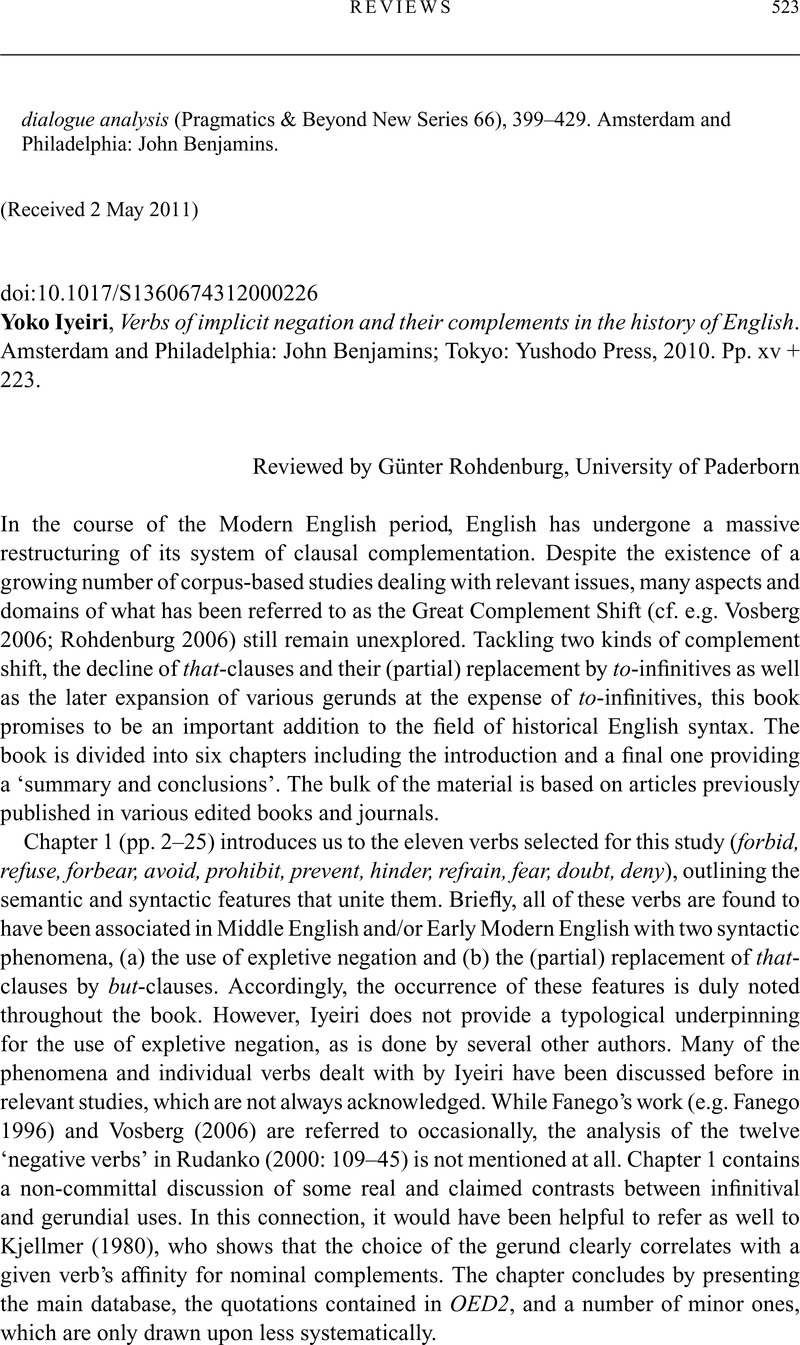No CrossRef data available.
Article contents
Yoko Iyeiri, Verbs of implicit negation and their complements in the history of English. Amsterdam and Philadelphia: John Benjamins; Tokyo: Yushodo Press, 2010. Pp. xv + 223.
Published online by Cambridge University Press: 22 October 2012
Abstract
An abstract is not available for this content so a preview has been provided. Please use the Get access link above for information on how to access this content.

- Type
- Reviews
- Information
- Copyright
- Copyright © Cambridge University Press 2012
References
Andersson, Evert. 1985. On verb complementation in written English (Lund Studies in English 71). Lund: Gleerup.Google Scholar
De Smet, Hendrik & Cuyckens, Hubert. 2007. Diachronic aspects of complementation: Constructions, entrenchment, and the matching problem. In Cain, Christopher & Russom, Geoffrey (eds.), Shaking the tree: Fresh perspectives on the genealogy of English, 187–213. Berlin: Mouton de Gruyter.Google Scholar
Elsness, Johan. 1984. That or zero? A look at the choice of object clause connective in a corpus of American English. English Studies 65, 519–33.Google Scholar
Fanego, Teresa. 1996. The development of gerunds as objects of subject-control verbs in English (1400–1760). Diachronica 13, 29–62.CrossRefGoogle Scholar
Hoffmann, Sebastian. 2004. Using the OED quotations database as a corpus – a linguistic appraisal. ICAME Journal 28, 17–29.Google Scholar
Kjellmer, Göran. 1980. Accustomed to swim: accustomed to swimming: On verbal forms after TO. In Allwood, Jens & Ljung, Magnus (eds.), ALVAR: A linguistically varied assortment of readings: Studies presented to Alvar Ellegard on the occasion of his 60th birthday, 75–99. University of Stockholm.Google Scholar
Mair, Christian. 2002. Three changing patterns of verb complementation in Late Modern English: A real-time study based on matching text corpora. English Language and Linguistics 6, 105–31.Google Scholar
Rohdenburg, Günter. 1995. On the replacement of finite complement clauses by infinitives in English. English Studies 76, 367–88.Google Scholar
Rohdenburg, Günter. 2000. The complexity principle as a factor determining grammatical variation and change in English. In Plag, Ingo & Schneider, Klaus P. (eds.), Language use, language acquisition and language history: (Mostly) empirical studies in honour of Rüdiger Zimmermann, 25–44. Trier: Wissenschaftlicher Verlag Trier.Google Scholar
Rohdenburg, Günter. 2006. The role of functional constraints in the evolution of the English complementation system. In Dalton-Puffer, Christiane, Kastovsky, Dieter, Ritt, Nikolaus & Schendl, Herbert (eds.), Syntax, style and grammatical norms: English from 1500–2000, 143–166. Bern etc.: Peter Lang.Google Scholar
Rudanko, Juhani. 2000. Corpora and complementation: Tracing sentential complementation patterns of nouns, adjectives and verbs over the last three centuries. Lanham, MD: University Press of America.Google Scholar
Vosberg, Uwe. 2006. Die große Komplementverschiebung: Außersemantische Einflüsse auf die Entwicklung satzwertiger Ergänzungen im Neuenglischen. Tübingen: Narr.Google Scholar




